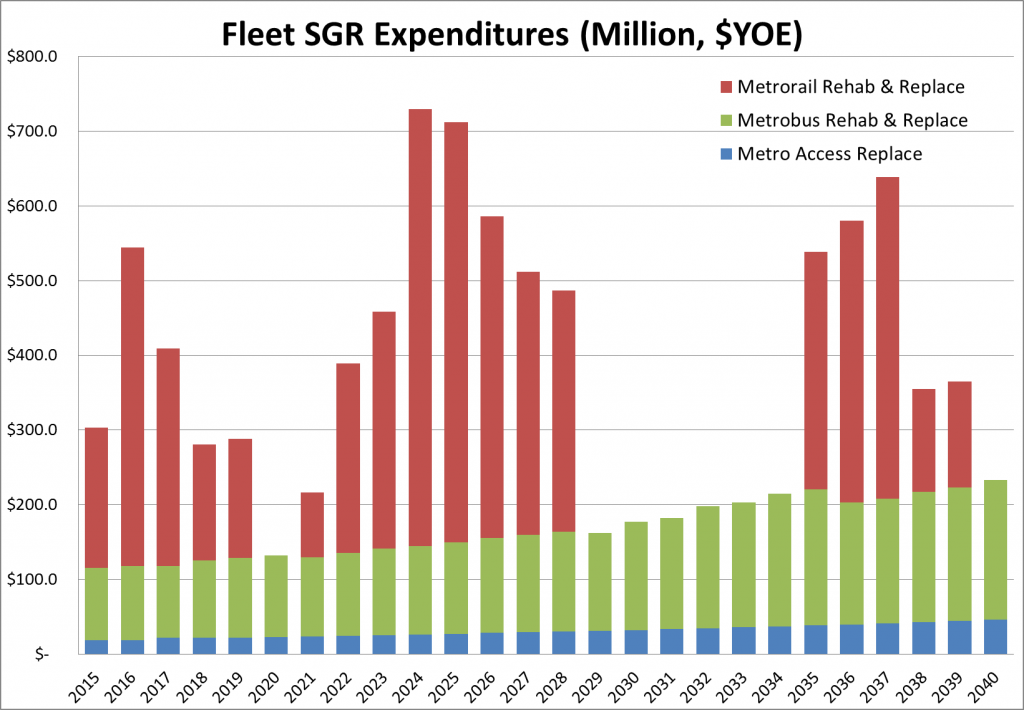Funding Metro – A Critical First Step
Local leaders are set to commit to Metro’s long term state of good repair needs for the first time through the region’s transportation plan, but the plan omits key investments that are critical to solving some of the region’s most critical needs.
This fall the region’s transportation leaders will approve an update the Constrained Long Range Plan (CLRP) financial plan, required by federal law every four years, to ensure the region’s ability to pay for transportation expenditures with reasonably anticipated revenues. During the 2014 update, Metro collaborated with staff from the Transportation Planning Board (TPB), the region’s Metropolitan Planning Organization, and the three state DOTs to identify funding for the system’s long-term operations and maintenance (O&M) and capital needs. The draft plan, which expresses the region’s major transportation priorities, is scheduled to be adopted by the TPB on October 15th.
State of Good Repair Commitment is a Big Step Forward for the Region
Although the region’s local governments, by way of the Metro Board of Directors, must annually approve funds through the budget for operations and capital needs, this is the first transportation plan to demonstrate that the region is committed to keeping its transit system up and running for the long term. The draft plan anticipates a commitment of funding from federal, state and local sources totaling $102 billion, including $76 billion in operating and $26 billion in capital funds, to address Metro’s existing and committed O&M needs through 2040. This includes funds to keep Metro’s buses, trains, MetroAccess vans, and infrastructure repaired and operating smoothly, while also supporting committed Metrorail expansion projects such as Phase Two of the Silver Line, the Potomac Yard Metro Station. This commitment is important not only because it demonstrates the region’s willingness to address one of our top priorities (PDF), but also because there are major expenses on the horizon, including vehicle replacements and mid-life rehabilitation for Metro’s fleet of well over 3,000 buses, trains, and vans (shown above).
Metro 2025 Expansion Needs Left Unfunded
Although the regional commitment to Metro’s long term operations and repair needs is big win for the regional rider, more is needed. The major repairs underway now are making up for many years of deferred maintenance and investment (PDF), bringing the system back to where it should have been all along rather than preparing for the future. But we need to do both. The region is growing, and increasingly inward and around Metro. On many streets, buses are carrying heavier loads and trains are increasingly crowded, while growth of Metro’s system is not projected to keep up. In fact, the TPB has noted that without funding to boost Metrorail core capacity, an additional 32,000 trips per day could be pushed onto the region’s roads each day by 2020. Despite those needs, and strong community support, the the local jurisdictions could not demonstrate the necessary capital funding availability to support including Metro 2025 projects such as 100% 8-car trains, core station improvements, and the Metrobus Priority Corridor Network into the region’s transportation plan.
Next Steps
You can provide your input on the proposed regional transportation plan to the TPB at their October 15th meeting, and you can endorse our strategic plan, Momentum, today. Even as the region moves towards adopting a plan without Metro 2025 investments, Metro will continue to work with our DC, MD, and VA funding partners to develop a capital funding agreement that will allow these initiatives to move forward. If local leaders can identify viable funding sources, Metro will work with the TPB to add these important investments to the regional transportation plan.




Does this include new lines?
I’ve been hoping for one down Columbia pike. Or just another line.